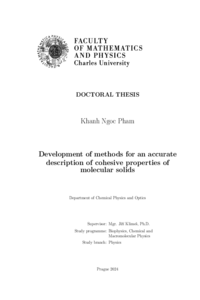Development of methods for an accurate description of cohesive properties of molecular solids
Vývoj metod pro přesný popis vazebných vlastností molekulárních krystalů
dissertation thesis (DEFENDED)

View/
Permanent link
http://hdl.handle.net/20.500.11956/195524Identifiers
Study Information System: 164277
Collections
- Kvalifikační práce [11973]
Author
Advisor
Referee
Karlický, František
Toman, Petr
Faculty / Institute
Faculty of Mathematics and Physics
Discipline
Biophysics, chemical and macromolecular physics
Department
Department of Chemical Physics and Optics
Date of defense
9. 10. 2024
Publisher
Univerzita Karlova, Matematicko-fyzikální fakultaLanguage
English
Grade
Pass
Keywords (Czech)
Molekulární krystaly|vazebná energie|periodické okrajové podmínky|mnohočásticová expanze|přiblížení náhodné fázeKeywords (English)
Molecular solids|binding energy|periodic boundary conditions|many body expansion|random phase approximationSpolehlivá předpověď struktury a stability molekulárních krystalů a jejich polymorfů je nezbytná pro pochopení jejich vlastností a potenciálních aplikací. Získání spolehlivé vazebné energie molekulárních pevných látek však vyžaduje použití přesných metod elektronové struktury a striktní konvergenci s numerickými parametry. To je obzvlášť náročné u molekulárních pevných látek s mnoha atomy v jednotkové buňce, pro které mohou být výpočty nesmírně časově náročné pokud je použita vysoce přesná teoretická metoda, jako např. spřažené klastry s jedno-, dvoj- a perturbativními tříčásticovými excitacemi (CCSD(T)). V této práci se zaměřujeme na vývoj a hodnocení přibližných metod schopných spolehlivě popsat vazebnou energii přičemž pro testy jsme použili čtyři molekulární krystaly vázané hlavně disperzními silami: ethan, ethylen a ortorombickou a kubickou formu acetylenu. Nejprve porovnáváme efektivitu výpočtů vazebné energie při použití periodických okrajových podmínek (PBC) a pro mnohočásticovou expanzi (MBE). Podrobně diskutujeme, jak obtížné je dosáhnout konvergovaných hodnot vazebné energie s ohledem na numerické parametry, a poté porovnáme výsledky získané z obou přístupů. Ve zbytku práce používáme výsledky získané pomocí MBE ke studiu přesnosti aproximace náhodné fáze (RPA) a Møller-Plessetovy (MP)...
Reliable prediction of the structure and stability of molecular crystals and their polymorphs is essential for understanding their properties and potential applications. However, obtaining reliable binding energies of molecular solids requires using high level electronic structure methods and strict convergence with numerical parameters. This becomes particularly challenging for molecular solids with many atoms in the unit cell, where calculations can become prohibitively expensive for high levels of theory, such as coupled clusters with singles, doubles, and perturbative triples (CCSD(T)). In this thesis, we focus on the development and assessment of approximate theoretical methods for calculation of binding energies and use four high-dispersion solids as test systems: ethane, ethylene, and orthorhombic and cubic forms of acetylene. To begin, we compare the efficiency of periodic boundary conditions (PBC) and many body expansion (MBE) approaches in calculating the binding energy of the considered systems. We discuss in detail how difficult it is to reach converged binding energy values with respect to the numerical parameters and then compare the results obtained from both approaches. In the remaining part of the thesis, we use the MBE results to examine the accuracy of random phase approximation...
